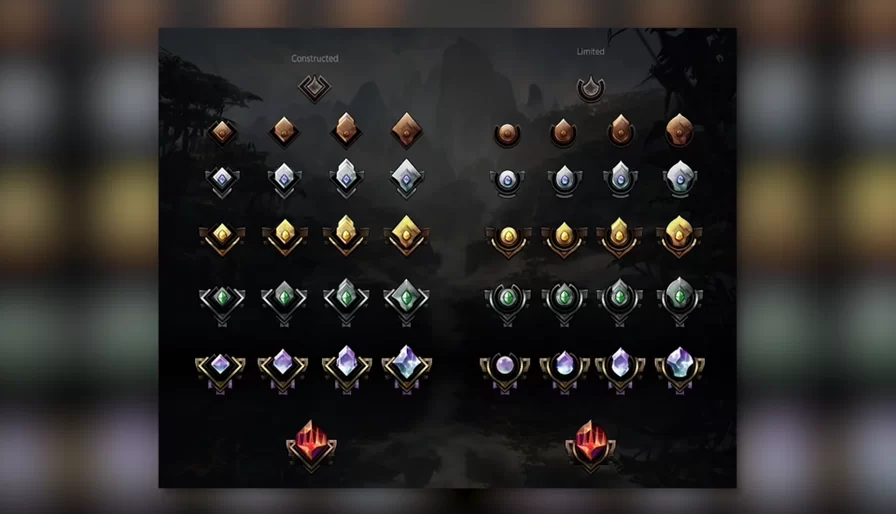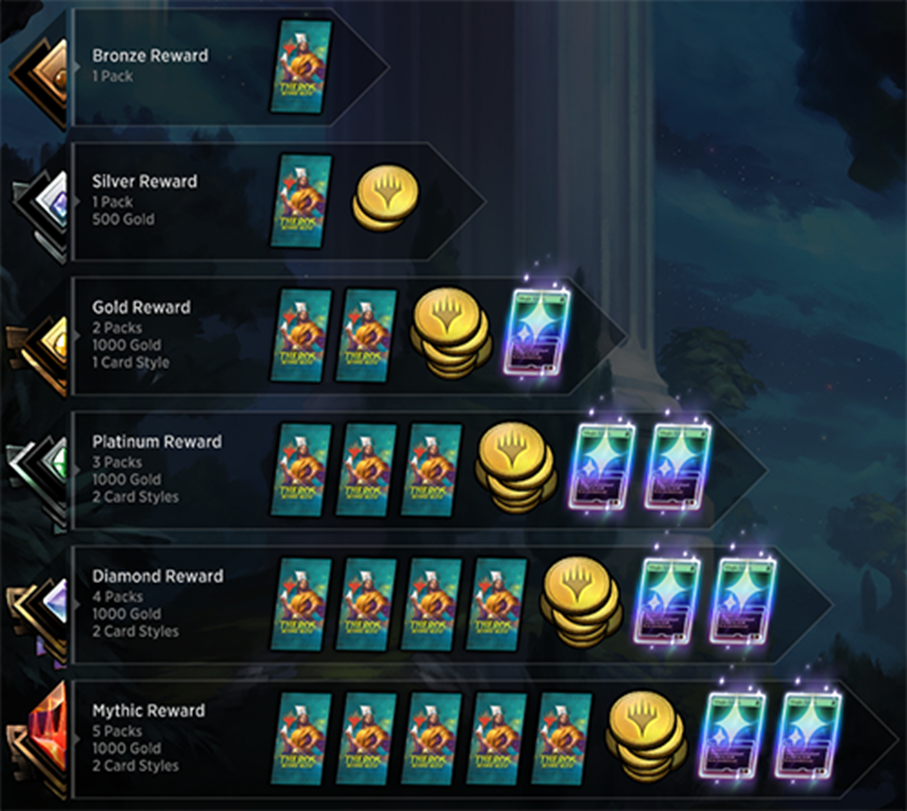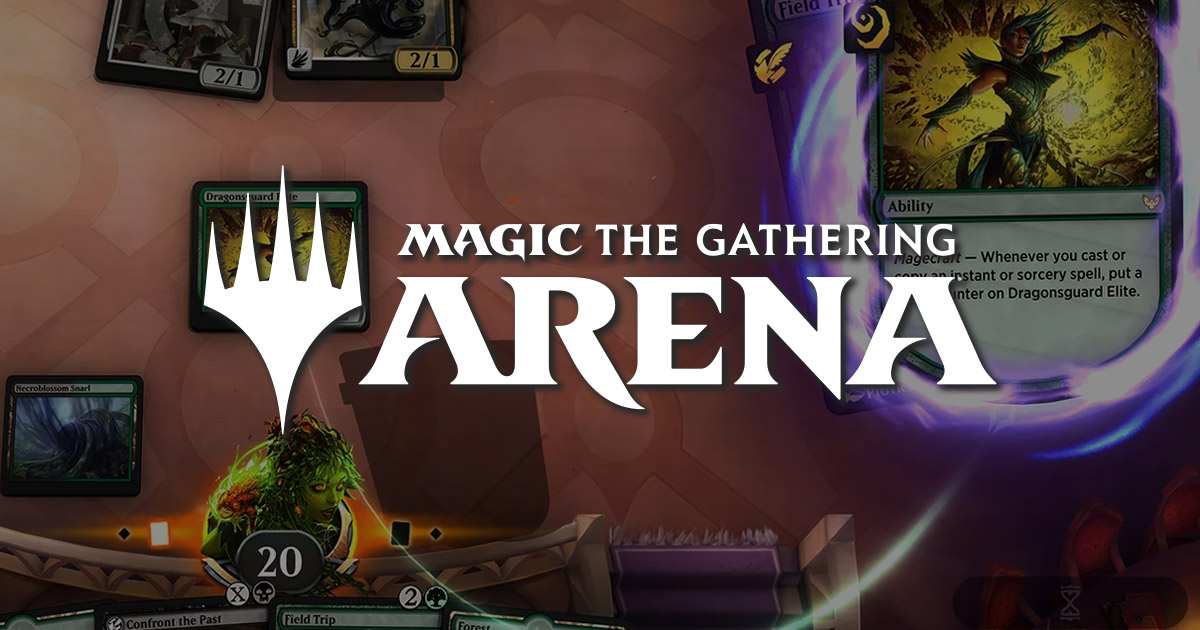If you’re unfamiliar with online multiplayer game ranking systems, such as those used in esports games like League of Legends, DOTA 2, CS:GO, or Valorant, then you’ll be unfamiliar with Magic Arena’s.
These ranking systems are all based on the Elo rating system (specifically a “Glicko style system” for Magic Arena) but hide the numbers and use more gamer-friendly tiers instead.
Even though games simplify the Elo system, even the simplified versions require some explanation. So here we are.
What are Magic Arena’s different ranks and what do they mean?
The ranking system in MTG Arena is divided into several tiers, starting with bronze and moving up to silver, gold, platinum, diamond, and finally mythic. Each tier from bronze to diamond is further divided into four divisions: IV, III, II, and I, with I being the highest.
The mythic rank, however, has no divisions but has a percentile for those in lower mythic, and a rank indicator for those in the top 1,000 players.
Each player starts at bronze IV and gains rank by winning games. Wins earn players ‘pips’ or progress markers, while losses will lead to a loss of pips in the higher tiers. The number of pips needed to advance to the next division or rank depends on the player’s current rank, and the number of pips gained or lost depends on whether the game was best of one or best of three (e.g., ‘standard’ or ‘traditional standard).
Can I drop a tier if I lose enough games?
Once you hit a new tier, for example, you move from bronze to silver, you can’t drop back to the previous tier for the remainder of the month. You can, however, drop as low as division IV with zero pips of your current tier. Note that mythic doesn’t have divisions, so mythic players can only drop as low as mythic 95%.
However, your Elo rating will always change, regardless of whether your tier can drop or not. This can create discrepancies between your tier and your hidden Elo rating, for example, if you’ve hit Mythic and lose 100 games in a row then your Elo rating might be in the bronze range and you could be facing bronze players as a mythic player.
This is one of the shortcomings of games like Magic Arena that hide your Elo rating behind a shiny overlay.
What formats are available for ranked play?
Ranked play is available for both traditional (best of three) and normal (best of one) queues for each constructed format:
- Standard
- Traditional standard
- Alchemy
- Traditional alchemy
- Historic
- Traditional historic
Playing any of the above constructed queues all affect your constructed ranking.
Limited formats like premier, quick and traditional drafts, as well as sealed, all affect your limited rating.
How do different ranks work with different queues?

Constructed and limited ranked games record your rating separately, but if you switch from traditional standard to historic, it will still affect the same constructed rating. This is great if you’re struggling in one metagame because you can try your luck in another.
What are the rewards for attaining different tiers?

The end of month rewards for attaining different ranks are as follows:
- Bronze: one pack.
- Silver: one pack, 500 gold.
- Gold: two packs, 1,000 gold, one card style.
- Platinum: three packs, 1,000 gold, two card styles.
- Diamond: four packs, 1,000 gold, two card styles
- Mythic: five packs, 1,000 gold, two card styles.
You’ll receive separate rewards for your constructed and limited ranks at the end of each month.
What’s the difference between Magic Arena’s ranked and play queues?
Magic Arena’s ranked games will adjust your hidden Elo rating and simplify it to a graphical tier system instead. Its unranked play queues, however, will weight your deck based on the number of rares and mythics in it, and match you based on that instead, meaning you’ll probably face back-to-back mirror matches.
Honestly, Magic Arena’s play queue matchmaking algorithm isn’t great and it’s almost always better to play ranked games instead. If you’re testing out a new deck, the perfect time to test it in ranked is when you’re at tier IV of bronze, silver, gold, etc., and with zero pips because you can’t drop down to a lower tier.
When does your rank reset?
Every month in MTG Arena is considered a competitive ‘season.’ At the end of each season, the rankings are reset, and players are rewarded based on the highest rank they achieved in that season. These rewards usually include card packs, individual card rewards (ICRs), and/or gold.
After the seasonal reset, players do not start from scratch. Instead, they are “soft reset” to a lower rank based on the rank they achieved in the previous season. This way, high-ranked players from the previous season still have a slight advantage going into the new one.
The exact amount your rank is dropped depends on where you finished the previous season. Higher ranks like diamond or mythic are typically reset back to gold, while lower ranks are reset less drastically.
What are the shortcomings of the system?
Like any competitive ranking system, the Magic Arena ranking system isn’t perfect and does have a few shortcomings.
Grind over skill
One common criticism is that the system rewards the quantity of games played (or grinding) over the quality of play. This is due to the fact that the system essentially allows for a player to reach higher ranks by simply playing a large volume of games, even with a win rate slightly above 50%. Thus, a player who spends more time on the game might have a higher rank than a potentially more skilled player who plays fewer games.
Rank inflation
The “soft reset” at the start of each new season can lead to a phenomenon known as rank inflation. This occurs because top players are reset to lower ranks, which can lead to uneven matches early in the season. This may create a frustrating experience for lower-ranked players who suddenly find themselves facing off against mythic opponents.
Not much reason to get mythic
Beyond bragging rights and personal satisfaction, there is limited motivation for players to reach the highest levels of play. The seasonal rewards for reaching mythic rank, while better than lower ranks, are not significantly greater. This lack of proportional rewards may discourage some players from investing the time and effort required to reach the top.
No differentiation for deck types
The ranking system doesn’t differentiate between different deck types. As a result, decks that lead to quicker games (often aggressive decks) can be favored in the ranking grind, as they allow players to play more games in a shorter amount of time.
Remember, though, that like any game, Magic Arena continues to evolve, and its ranking system may undergo changes over time. The developers may address these issues as they update the game, so always look for the most recent information.

